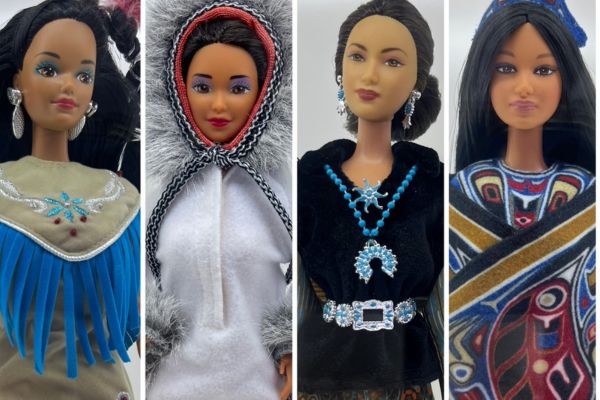
- Details
- By Neely Bardwell
Despite the lack of Indigenous representation, the movie didn’t stray away from making an off-hand one-liner about the genocide of Native people. Mid-way through the movie Ken (Ryan Gosling) comes back from the “real world” and introduces patriarchy to the Barbies, disrupting their harmonious Barbie Land. America Ferrara’s character, Gloria from the human world, compares Barbie’s lack of immunity to patriarchy to Native people and the introduction of smallpox.
Although the movie included no Indigenous representation, this does not mean that there are no Native Barbies released by Mattel, the doll’s manufacturing company. Let’s dive into the history of the Native American Barbie.
The first Native Barbie was E**imo Barbie, using a derogatory slur for the Indigenous people who reside in Alaska and the Arctic regions, released in 1981 as part of the Dolls of the World International Series. She stood alone for over a decade until “First Edition Native American Barbie” was released in 1993 as part of the company’s “Dolls of the World” Collection. She was dressed in a white “buckskin” top and skirt with white fringe and adorned with long black hair and tanned skin.
Multiple Native Barbies have been released since then, including second, third and fourth editions of the original and a Barbie line titled the “Native Spirit Collection.” The first Barbie in that collection was Spirit of the Earth Barbie. There is even a Barbie at the Smithsonian, the Northwest Coast Barbie, released in 2000.
The dolls are always accompanied by an introduction of who they are and an explanation of their clothing. Third Edition Native American Barbie (1994) is described like this:
“My dancing outfit is an updated version of a tribal princess costume. It’s a mix of traditional style with the latest colors and accessories of today! I’ll be pretty in my pink tunic and skirt with geometric patterns, white fringe, and ribbon trim. My moccasins, beaded necklace, turquoise earrings, and ring complete my modern-day powwow look!”
The Native American Barbies are described as “princesses,” fueling the “Indian Princess” stereotype that we see every year during Halloween. It reduces Indigenous women’s experience to that of a costume, effectively eliminating the spiritual, cultural, and traditional importance of regalia and the sacred nature of what we wear and why.
Barbie herself is a product of patriarchy and colonization. Barbie movie explores the sad reality of women in a patriarchal society, and the movie pulls heartstrings. It shared the experience of growing up as a woman, the experience of constantly being told what to do, what to look like, what not to do, what not to wear, and overall just living a life policed and dominated by men.
As Indigenous women, we have a unique relationship with patriarchy and colonization, as the two go hand in hand. A 2016 study by the National Institute of Justice (NIJ) found that more than four in five American Indian and Alaska Native women have experienced violence in their lifetime, including 56.1 percent who have experienced sexual violence–trauma that has been ongoing since colonization.
The male gaze created Barbie, and the colonized gaze continues to misrepresent the Indigenous experience in both the product line and film inspired by it.
While doing a successful job of portraying the general experience of women under patriarchy, the film fails to include the intricate and unique experience of Indigenous women within the patriarchy–and under the colonized gaze of women and men alike.
Without this, the story is incomplete.
More Stories Like This
Zuni Youth Enrichment Project Takes Top Emerging Artist Apprentices to Phoenix for Artistic Exploration and Cultural ImmersionFrom Dishwasher to Award-Winning Chef: Laguna Pueblo's Josh Aragon Serves Up Albuquerque's Best Green Chile Stew
Rob Reiner's Final Work as Producer Appears to Address MMIP Crisis
Vision Maker Media Honors MacDonald Siblings With 2025 Frank Blythe Award
First Tribally Owned Gallery in Tulsa Debuts ‘Mvskokvlke: Road of Strength’
Help us defend tribal sovereignty.
At Native News Online, our mission is rooted in telling the stories that strengthen sovereignty and uplift Indigenous voices — not just at year’s end, but every single day.
Because of your generosity last year, we were able to keep our reporters on the ground in tribal communities, at national gatherings and in the halls of Congress — covering the issues that matter most to Indian Country: sovereignty, culture, education, health and economic opportunity.
That support sustained us through a tough year in 2025. Now, as we look to the year ahead, we need your help right now to ensure warrior journalism remains strong — reporting that defends tribal sovereignty, amplifies Native truth, and holds power accountable.
 The stakes couldn't be higher. Your support keeps Native voices heard, Native stories told and Native sovereignty defended.
The stakes couldn't be higher. Your support keeps Native voices heard, Native stories told and Native sovereignty defended.
Stand with Warrior Journalism today.
Levi Rickert (Potawatomi), Editor & Publisher


